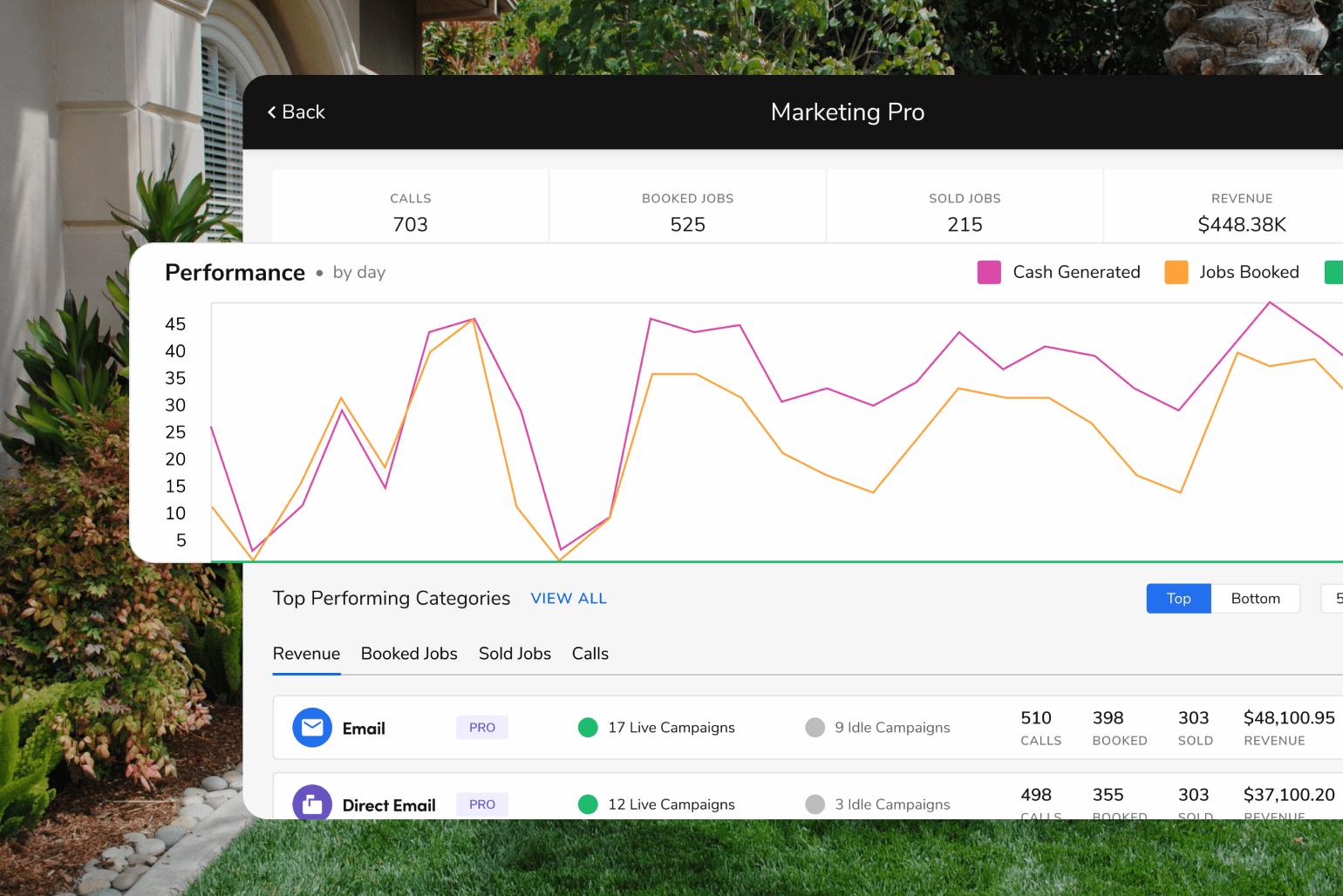Managing Seasonal Fluctuations in Pest Control

Seasonal fluctuations are a real challenge for pest control businesses—inconsistent revenue, hard-to-retain skilled staff during the off-season, and constant changes to marketing strategies. As pest activity increases with changing seasons and environmental conditions, it can be tough to stay financially stable.
However, with proactive strategies and the right tools, businesses can navigate these challenges and thrive all year round.
In this guide, we’ll look at the causes of seasonal demand, how to predict these changes, how to manage fluctuations, and how using FieldRoutes can help keep you efficient throughout the season.
What Causes Seasonal Pest Control Demand?
Seasonal demand for pest control services is linked to weather patterns, pest life cycles, and pest behavior.
Different pests thrive in various conditions, which leads to fluctuations in activity and, ultimately, customer demand. For example, mosquitoes breed in the warmer months when humidity and standing water create the perfect breeding ground.
Rodents and cockroaches become more of a problem in winter as they seek shelter and food in homes and buildings to escape the cold.
Wind and air currents can carry pests long distances, create new infestations, and spread pest-borne diseases.
Other seasonal pests, such as termites and bed bugs, have different activity levels at various times of the year, depending on weather and food sources. Fleas, wasps, and common pests like ants have cycles that match the seasons, which affects pest control demand throughout the year.
Knowing these seasonal changes helps pest control businesses anticipate customer needs and plan their pest control strategies.
How Can Seasonal Fluctuations in Pest Control Affect Your Business?
Pest life cycles
Different pests are active at different times of the year.
For example, mosquitoes and wasps are more active in the warmer months, while rodents and cockroaches seek shelter in homes during the colder months. Knowing the signs of insect infestation and the importance of early detection is vital to preventing property and health damage.
These fluctuations create inconsistent demand. Some pests only become a major problem at certain times of the year, so having a steady stream of customers is hard.
Impact on Revenue
Seasonal fluctuations create peaks and troughs.
Preventing future infestations is vital to protecting a business’s reputation and long-term benefits. During high-demand seasons like spring and summer, pest control businesses will get an influx of customers with infestations.
However, demand drops sharply as the temperature cools, resulting in slower periods and cash flow challenges. These seasonal changes put financial pressure on businesses to balance high revenue periods with slower off-seasons.
Other Challenges
Beyond revenue, seasonality affects other areas of the business.
Staffing becomes tricky, as hiring skilled technicians for busy seasons means layoffs or reduced hours during quiet periods. Inventory management for products like pesticides and sprayers becomes more complicated with overstock or understock risks. Retaining customers year-round is hard when seasonal pests are no longer a problem for homeowners, and they won’t be repeat customers.
Knowing these challenges, pest control businesses can develop integrated pest management strategies to minimize the impact of seasonal demand on their operations and provide year-round professional pest control services.
How Can You Predict Seasonal Pest Demand Changes?
Predicting seasonal demand changes for your pest control business involves tracking historical data and weather forecasts to anticipate pest activity.
Knowing the obvious signs of infestation, such as visible pests, unusual sounds, and persistent odors, is key to preventing pest problems from getting out of hand.
By reviewing past service records, you can see when certain pests are most active throughout the year.
For example, cockroaches and rodents will invade homes in the winter months to escape the cold. Monitoring weather patterns like humidity and temperature changes will help you know when pests (such as termites) will look for new habitats so you can prepare for service requests ahead of time.
Winter Pest Problems
Here are some common winter pests that may require attention:
Cockroaches: During colder months, American and German cockroaches enter homes for food and warmth. These pests can trigger health risks, spread bacteria like E. coli and Salmonella, and cause asthma attacks or allergic reactions.
Rodents: Nearly 50% of all rodent infestations occur in the fall and winter as rats and mice seek warmth indoors. Rodents can spread over 35 diseases, so proactive measures like sealing entry points and checking attics are critical to prevent infestations.
Termites: While some termites become less active in colder weather, they will continue to be a threat. States with high humidity levels attract termites, which feed on wood structures and cause significant damage. Signs of infestation are shed wings, mud tunnels, and swollen walls.
Pest control software like FieldRoutes can help you track trends and make data-driven decisions. Using historical data and predictive tools to analyze past services, current demand, and forecasted pest activity, you can adjust your pest control strategies, staffing, and inventory for the season ahead.
What Are Some Proactive Strategies to Manage Seasonal Fluctuations?
Planning and proactive action are key to managing seasonal fluctuations, and these strategies can help pest control businesses remain stable year-round while maximizing revenue when the temperatures drop and during other quiet periods.
1. Financial Planning
Create a cash flow forecast: By knowing when the quiet periods are, you can anticipate when revenue will dip and adjust your financial plans accordingly.
Set aside reserves: During peak seasons, set aside a portion of your profits for a reserve fund to cover costs during the quiet months.
Explore financing options: Consider applying for a line of credit or other financing to keep operations running during the off-season and repaying during the high season.
Good financial planning helps you prepare for seasonal changes and stabilize your business when pest activity slows down.
2. Staffing Strategies
Cross-train employees: Train your staff to do multiple tasks so they can do different jobs when pest control demand slows. Pest control staff could be trained on various activities, such as conducting property inspections for potential pest entry points and offering maintenance services like sealing cracks or repairing insulation before warmer temperatures return.
Incentive programs: Offer bonuses or incentives to retain skilled staff during the off-season. Help them undertake training or certification courses to enhance skills and knowledge for the upcoming busy seasons.
Utilize part-time or seasonal labor: Hire temporary staff during peak seasons so you don’t have to lay off full-time staff during quiet periods.
Proactive pest management: Emphasize proactive pest management in residential and commercial settings to prevent infestations and adapt to seasonal changes. You could also ask staff to educate customers on winter pest prevention.
With a flexible staffing strategy, you can have the right staff for peak times without overstaffing during quiet months.
3. Service Diversification
Expand into off-season services: Offer preventative treatments, inspections, or services like termite monitoring during quiet months. Emphasize the importance of preventative measures to reduce the risk of infestations.
Offer bundled packages: Create year-round contracts that bundle pest prevention and seasonal treatments and encourage customer loyalty.
Monthly subscriptions: Customers pay the same amount each month, so they know how to budget without worrying about paying more in the summer when more infestations occur. This also ensures monthly recurring revenue for your business.
Diversifying services generates consistent revenue, provides more value to customers, and keeps them engaged with your business all year round.
4. Marketing and Sales Tactics
Adjust marketing campaigns: Tailor your messaging to seasonal pest issues, such as rodents in winter or mosquito breeding in summer. Guarantee pest-free homes to homeowners no matter the time of year.
Run off-season promotions: Offer discounts or service incentives during quiet months to attract business. For example, food safety is critical to restaurants, as pest infestations in food establishments pose significant health risks by contaminating food products. So run campaigns, both educational and for pest control, highlighting how food must be sealed in airtight containers to comply with food safety regulations and how different types of pests can spread diseases through their bodily fluids and contaminants and transmit health hazards like E.coli and Salmonella. And, of course, your services on how to obtain a pest-free environment.
Focus on customer retention: Implement loyalty programs or incentives for customers who schedule recurring pest control services all year round.
Using targeted marketing, you can keep customers interested and attract new customers during quiet periods.
5. Operational Efficiency
Optimize routes and schedules: Use route optimization software to reduce travel time and fuel costs and increase technician productivity.
Lean inventory management: Track pest control products closely to avoid overstocking during quiet months or understocking during busy periods. FieldRoutes has historical data to show what has been purchased and how much.
Operational efficiency helps control costs and keep your business agile to respond to seasonal pest issues in the winter or summer months.
By following these tips, you can provide effective pest control services year-round, and your business will be resilient and profitable.
How Can Pest Control Businesses Leverage Technology to Manage Seasonal Fluctuations?
Using technology is pivotal for pest control businesses to navigate the ups and downs of seasonal fluctuations.
With specialized software, businesses can automate, optimize, and communicate with customers while staying agile during peak and quiet periods.
Addressing pest infestations promptly is critical to mitigate health risks and protect customers and businesses. FieldRoutes has the tools to help businesses manage customer pest concerns and, hence, remain competitive all year round.
Key Features to Manage Seasonal Fluctuations
Automated Scheduling: Busy periods of pest invasions mean high demand for pest control methods. FieldRoutes automates the booking process so you can adjust staff levels based on customer demand. This way, you can handle an influx of jobs without overwhelming your team or missing out on new business.
Route Optimization: During peak seasons, route optimization is key. By reducing fuel costs and travel time, FieldRoutes’ routing software allows technicians to do more jobs in less time. This is especially important when termite or rodent control is in high demand in the summer and winter months.
Customer Management: Relationships with your customers are key to success, especially when demand fluctuates. With FieldRoutes’ customer management tools, you can send service reminders, follow-up emails, and targeted communications to customers all year round. This is especially useful for promoting preventive measures during quiet months.
Marketing Tools: Seasonal promotions can generate new business during quiet periods. FieldRoutes has marketing tools to create targeted campaigns to attract new customers or promote off-season services such as preventative treatments or regular inspections.
Inventory Management: Lean inventory management means you have the right stock of pesticides and products when demand changes. FieldRoutes helps businesses track and adjust inventory levels by season to avoid overstocking or understocking during peak periods.
Using FieldRoutes’ all-in-one platform, pest control businesses can anticipate seasonal weather conditions and run consistently during peak and quiet periods.
The Bottom Line
Managing seasonal fluctuations in the pest control industry requires a combination of proactive strategies such as financial planning, staff flexibility, service diversification, and targeted marketing. By anticipating pest behavior and customer demand, businesses can stabilize revenue, retain skilled staff, and be efficient all year round.
Using technology, especially through FieldRoutes, can take these to the next level by automating scheduling, route optimization, customer management, and marketing tools. These features will keep you responsive and efficient during peak and quiet periods and give you a competitive advantage.
To see how FieldRoutes can streamline your pest control operations, schedule a free demo today: Schedule a Free Demo.





